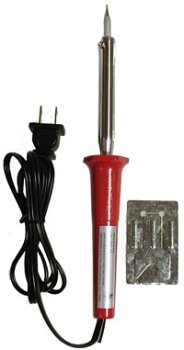In good condition, these guns are valuable antique collectors' pieces. Others that require a bit of work can often be cleaned and restored by amateurs. Cast-metal parts or wooden blanks, which can be shaped to replace damaged or missing stocks, can be obtained from specialist suppliers. Even old gunpowder explodes, so be sure that any gun being repaired is not loaded. Insert the ramrod, or a length of wood, into the barrel to check if there is any obstruction. If there is, remove it with a modern shotgun-cleaning rod that has a screw tip, or use an ordinary steel screw soldered to a stiff piece of wire. Screw the rod gently into the obstruction and pull it out like a cork. Wash the barrel with hot water and dry it.
To dismantle the gun, first half-cock it, then remove the screw which holds the cock (in the flintlock) or the hammer (in the percussion type) and slide it off. Unscrew the pan-cover pivot and screw securing the spring beneath the pan: remove the parts. Unscrew the holding bolts or screws and remove the lock-plate. Several screwdrivers may be needed: the blade must fit each screw or bolt slot exactly so as not to burr the screw or bolt. If they are hard to remove, applying a bit of penetrating oil will do the trick. To dismantle a flintlock mechanism, loosen the four screws that hold the mainspring, sear, searspring and the bridle. Compress the mainspring (in a small hand vice), take out the spring screw and remove the spring. The pin at the rear of the mainspring engages in the lock-plate and the other end of the spring engages in the toe of the tumbler.
Soldering Gun
Remove rust with fine emery paper or powder. Make sure to remove all abrasive powder after cleaning. Smear all parts with petroleum jelly and reassemble. Press the tumbler down to the fired position so that the end of the mainspring goes over it. Put the cock on and pull it back to the half-cocked position so that the tumbler toe compresses the mainspring. Refit the rest of the pieces in reverse order to removal.
To clean the barrel, first remove it from the stock. A metal extension of the barrel - the tang - runs into the stock. Remove the tang screws and any retaining bands or pins. The trigger guard, butt cap and ramrod pipes are screwed or pinned and must be removed with extreme care. If the screws do not yield to penetrating oil, leave them alone - it will be a job for an antique restorer to drill them out. Barrels and other metal parts can be cleaned with a mixture of oil and paraffin. Re-polish all parts with progressively finer abrasives; finish with jewellers' emery or crocus paper. Some barrels may have been blued to prevent rust and, special bluing fluid can be bought from a gunsmith. Try not leaving fingerprints on the barrel as this causes rusting.
Clean the stock with steel wool and linseed oil. If the stock is broken, mend with epoxy resin mixed to a paste with matching stained sawdust. If the stock is beyond minor repairs, a new stock may be fashioned with an entirely new piece of wood. Small dents in the stock can be extracted by using hot steam from an iron. Place a cloth over the dent and apply the hot iron.
Powder flasks were made in hundreds of designs and several materials. However, the majority of antique flasks were made pear-shaped and made from tin, brass or Britannia metal. Metal flasks were usually made in two halves soldered together. If the seam has parted, find out what alloy the flask is made of before trying to re-solder it. A simple test is to put a few drops of water in a cup and add an equal number of drops of nitric acid, obtainable from a chemist. Put a drop of the solution on the metal to reveal the colour. Red-brown indicates bronze; yellow and yellow-red, brass; dark grey, pewter; and bright silver-grey, Britannia metal. To polish the antique flask, use the technique appropriate to the material it is made of. Many powder flasks have very fine detailed etchings, embossings or engravings that give them their unique look. An antique gun without its matching or specific powder flask loses its appeal when antique collectors are looking to add to their collection.
Special Price!!! Sinometer 30 Watts Soldering Iron, UL listed
Nov 01, 2011 00:59:18
Click for larger image and other views

Sinometer 30 Watts Soldering Iron, UL listed Feature
- Long life replaceable tip
- 30 Watts and UL listed
- Stand included
- Impact resistance handle
- 30 days money back guarantee and 1 year limited warranty
Sinometer 30 Watts Soldering Iron, UL listed Overview
This professional 30 watt soldering iron features a replaceable tip, ergonomically designed cool grip rubber handle, and a nickel-iron plated long life copper tip. It provides an operating tip temperature of up to 430 F with fast heating time and quick heating recovery. 120 VAC.SAVE NOW on the special offers below!
Available In Stock. |
| This Sinometer 30 Watts Soldering Iron, UL listed ships for FREE with Super Saver Shipping. |
Price : Click to Check Update Prices Please. |
